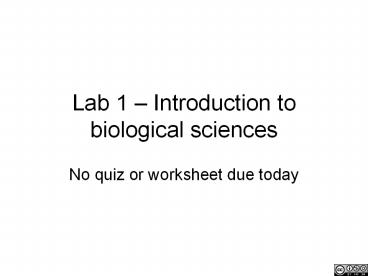Lab 1 PowerPoint PPT Presentation
1 / 18
Title: Lab 1
1
Lab 1 Introduction to biological sciences
- No quiz or worksheet due today
2
Outline of todays lab
- Atoms
- What are they made of?
- What makes different atoms different?
- How are ions and anions formed?
- pH
- What is it?
- What is the pH of various solutions?
- What are buffers?
- Using the metric system
- Practicing measurements / unit conversions.
3
Atoms!
- Composed of protons, neutrons, and electrons
- Protons 1 charge
- Electrons -1 charge
- Neutrons neutral
- Bohr Model is the classic model
- Protons and neutrons in the nucleus
- Electrons in shells around the nucleus
Bohr model of Boron
Periodic table ccasa by Armtuk http//commons.wiki
media.org/wiki/ImagePeriodic_Table_Armtuk3.svg
Boron art by Marc Perkins
4
How do we figure out whats in each atom?
B
5
Boron
- Protons
- protons Atomic number
- Neutrons
- neutrons Atomic mass - protons
- Unless its an isotope
- Electrons
- electrons protons
- Unless its an ion
10.81
5
Ions gaining or losing electrons
- Salt
- NaCl
- Sodium Chloride
- Na and Cl become ions
- Na loses an electron
- Cl gains an electron
- Written as
- Na
- Cl-
Chlorine atom (Cl)
Sodium atom (Na)
Chlorine atom (Cl-)
Sodium atom (Na)
6
The periodic table
Periodic table ccasa by Armtuk http//commons.wiki
media.org/wiki/ImagePeriodic_Table_Armtuk3.svg
Boron art by Marc Perkins
7
Outline of todays lab
- Atoms
- What are they made of?
- What makes different atoms different?
- How are ions and anions formed?
- pH
- What is it?
- What is the pH of various solutions?
- What are buffers?
- Using the metric system
- Practicing measurements / unit conversions
8
Acidity
- Completely dependent on the concentration of
protons (H) in solution - The more protons (H), the more acidic
- The more things that absorb protons (e.g., OH-),
the more basic
pH Scale ccasa by Slower http//commons.wikimedia
.org/wiki/ImagePH_scale.png
9
Acid
Base
(hydrochloric acid)
(sodium hydroxide / lye)
10
pHs of common items
pH Scale ccasa by Slower http//commons.wikimedia
.org/wiki/ImagePH_scale.png
11
Buffers
- Chemicals that maintain a constant pH in a
solution, even when acid or base is added - Example Bicarbonate (NaHCO3)
- In solution dissociates into Na and (HCO3)-
Bicarbonate absorbs the proton!
Bicarbonate produces a proton! (that will react
with OH- to form H2O)
12
Outline of todays lab
- Atoms
- What are they made of?
- What makes different atoms different?
- How are ions and anions formed?
- pH
- What is it?
- What is the pH of various solutions?
- What are buffers?
- Using the metric system
- Practicing measurements / unit conversions
13
Measuring volume
- Use the pipettes, graduated cylinders, or the
scale - 1 ml H2O 1g
Read the volume at the bottom of the meniscus
Meniscus diagram gnu FDL by Jleedev
http//en.wikipedia.org/wiki/ImageReading_the_men
iscus.png
14
The periodic table
Periodic table ccasa by Armtuk http//commons.wiki
media.org/wiki/ImagePeriodic_Table_Armtuk3.svg
Boron art by Marc Perkins
15
Before you leave
- Clean up your work area
- Wash glassware and store upside down
- Show me your lab report so I can stamp it
- Need to have all data fields filled in
- Complete at home and then turn in at the
beginning of next lab - Remember that well have a quiz at the beginning
of the next class - 6-7 questions on todays lab
- 3-4 questions on the lab well do next week
16
Notes for the instructor
- If you need a screen-displayable periodic table
that shows atomic masses, try this one by the
IUPAC - http//www.iupac.org/reports/periodic_table/
17
License information
- This work is licensed under the Creative Commons
Attribution-NonCommercial-ShareAlike 3.0 License.
To view a copy of this license, visit
http//creativecommons.org/licenses/by-nc-sa/3.0/u
s/ or send a letter to Creative Commons, 171
Second Street, Suite 300, San Francisco,
California, 94105, USA. - The slides in this presentation were originally
created by Marc C. Perkins (http//faculty.orangec
oastcollege.edu/mperkins). - You are free to use, modify, and distribute these
slides according to the terms of the Creative
Commons license (e.g., you must attribute the
slides, no commercial uses are allowed, and
future distributions must be licensed under a
similar license). - Attribution should be given to Marc C. Perkins
(and any later editors), including a link back to
Marcs current website. This applies both while
distributing the slides and during use of the
slides attribution during use can be satisfied
by, for instance, placing small text on at least
one of the slides that has been shown (see below
for an example).
Slides in this presentation based on those
created by Marc C. Perkins. http//faculty.orangec
oastcollege.edu/mperkins
18
History
- August 2007 Marc Perkins released first version.
http//faculty.orangecoastcollege.edu/mperkins
(If you modify these slides and redistribute
them, add your information to the list)

